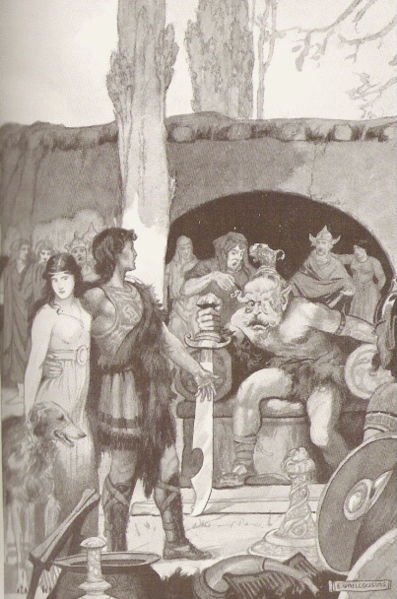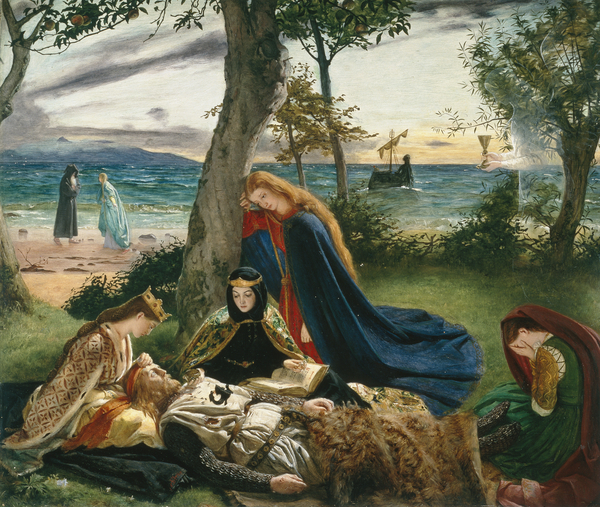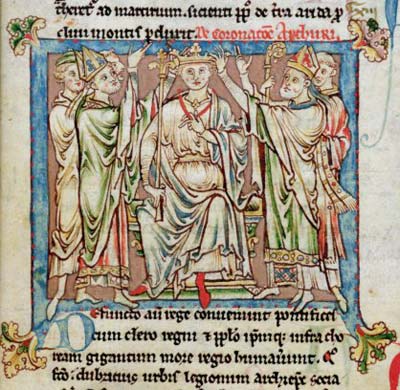|
Pridwen
Pridwen was, according to the 12th-century writer Geoffrey of Monmouth, King Arthur's shield; it was adorned with an image of the Virgin Mary. Geoffrey's description of it draws on earlier Welsh traditions found in ''Preiddeu Annwfn'', ''Culhwch and Olwen'', and the ''Historia Brittonum''. The shield is also named and described by Wace, Layamon, Roger of Wendover and Robert of Gloucester among other medieval writers, and it directly inspired the description of Sir Gawain's shield in ''Sir Gawain and the Green Knight''. Geoffrey of Monmouth King Arthur's shield Pridwen appears in the 1130s in Geoffrey of Monmouth's largely fictitious ''Historia Regum Britanniae''. Before fighting a battle near Bath, in Somerset, Arthur ''Pridwen'' was the name of King Arthur's shield. The name was taken from Welsh tradition, Arthur's ship in ''Preiddeu Annwfn'' and ''Culhwch and Olwen'' being called '' Prydwen''; it was perhaps borrowed by Geoffrey because of its appropriateness to a pi ... [...More Info...] [...Related Items...] OR: [Wikipedia] [Google] [Baidu] |
Prydwen
''Prydwen'' plays a part in the early Welsh poem ''Preiddeu Annwfn'' as King Arthur's ship, which bears him to the Celtic otherworld Annwn, while in ''Culhwch and Olwen'' he sails in it on expeditions to Ireland. The 12th-century chronicler Geoffrey of Monmouth named Arthur's shield after it. In the early modern period Welsh folklore preferred to give Arthur's ship the name ''Gwennan''. ''Prydwen'' has however made a return during the last century in several Arthurian works of fiction. ''Preiddeu Annwfn'' Arthur's ship makes an early appearance in ''Preiddeu Annwfn'' ("The Spoils of Annwn"), a Welsh mythological poem of uncertain date (possibly as early as the 9th century or as late as the 12th) preserved in the Book of Taliesin. The meaning of the poem is in many places obscure, but it seems to describe a voyage in ''Pridwen'' to Annwn, the Celtic otherworld, to rescue a prisoner held there. It includes two lines translated by John K. Bollard as And again later ... [...More Info...] [...Related Items...] OR: [Wikipedia] [Google] [Baidu] |
Excalibur
Excalibur is the mythical sword of King Arthur that may possess magical powers or be associated with the rightful sovereignty of Britain. Its first reliably datable appearance is found in Geoffrey of Monmouth's ''Historia Regum Britanniae''. Excalibur as the "sword in the stone" functioning as the proof of Arthur's lineage is an iconic motif featured throughout most works dealing with Arthur's youth since its introduction in Robert de Boron's ''Merlin''. The sword given to the young Arthur by the Lady of the Lake in the tradition that began soon afterwards with the '' Post-Vulgate Cycle'' is not the same weapon, but in '' Le Morte d'Arthur'' both of them share the name of Excalibur. Several similar swords and other weapons also appear within Arthurian texts, as well as in other legends. Forms and etymology The name ''Excalibur'' ultimately derives from the Welsh ( Breton , Middle Cornish ), which is a compound of , , and , . Caledfwlch appears in several early Welsh wo ... [...More Info...] [...Related Items...] OR: [Wikipedia] [Google] [Baidu] |
Culhwch And Olwen
''Culhwch and Olwen'' () is a Welsh tale that survives in only two manuscripts about a hero connected with Arthur and his warriors: a complete version in the Red Book of Hergest, , and a fragmented version in the White Book of Rhydderch, . It is the longest of the surviving Welsh prose tales. Lady Charlotte Guest included this tale among those she collected under the title ''The Mabinogion''. Synopsis Culhwch's father, King Cilydd son of Celyddon, loses his wife Goleuddydd after a difficult childbirth. When he remarries, the young Culhwch rejects his stepmother's attempt to pair him with his new stepsister. Offended, the new queen puts a curse on him so that he can marry no one besides the beautiful Olwen, daughter of the giant Ysbaddaden Pencawr. Though he has never seen her, Culhwch becomes infatuated with her, but his father warns him that he will never find her without the aid of his famous cousin Arthur. The young man immediately sets off to seek his kinsman. He find ... [...More Info...] [...Related Items...] OR: [Wikipedia] [Google] [Baidu] |
Avalon
Avalon () is an island featured in the Arthurian legend. It first appeared in Geoffrey of Monmouth's 1136 ''Historia Regum Britanniae'' as a place of magic where King Arthur's sword Excalibur was made and later where Arthur was taken to recover from being gravely wounded at the Battle of Camlann. Since then, the island has become a symbol of Arthurian mythology, similar to Arthur's castle of Camelot. Avalon was associated from an early date with mystical practices and magical figures such as King Arthur's sorceress sister Morgan, cast as the island's ruler by Geoffrey and many later authors. Certain Briton traditions have maintained that Arthur is an eternal king who had never truly died but would return as the "once and future" king. The particular motif of his rest in Morgan's care in Avalon has become especially popular. It can be found in various versions in many French and other medieval Arthurian and other works written in the wake of Geoffrey, some of them also linkin ... [...More Info...] [...Related Items...] OR: [Wikipedia] [Google] [Baidu] |
Arthurian Legend
The Matter of Britain (; ; ; ) is the body of medieval literature and legendary material associated with Great Britain and Brittany and the legendary kings and heroes associated with it, particularly King Arthur. The 12th-century writer Geoffrey of Monmouth's (''History of the Kings of Britain)'' is a central component of the Matter of Britain. It was one of the three great Western story cycles recalled repeatedly in medieval literature, together with the Matter of France, which concerned the legends of Charlemagne and his companions, as well as the Matter of Rome, which included material derived from or inspired by classical mythology and classical history. Its pseudo-chronicle and chivalric romance works, written both in prose and verse, flourished from the 12th to the 16th century. Name The three "matters" were first described in the 12th century by French poet Jean Bodel, whose epic ' ("Song of the Saxons") contains the lines: The name distinguishes and relates the ... [...More Info...] [...Related Items...] OR: [Wikipedia] [Google] [Baidu] |
Middle English
Middle English (abbreviated to ME) is a form of the English language that was spoken after the Norman Conquest of 1066, until the late 15th century. The English language underwent distinct variations and developments following the Old English period. Scholarly opinion varies, but the University of Valencia states the period when Middle English was spoken as being from 1150 to 1500. This stage of the development of the English language roughly coincided with the High Middle Ages, High and Late Middle Ages. Middle English saw significant changes to its vocabulary, grammar, pronunciation, and orthography. Writing conventions during the Middle English period varied widely. Examples of writing from this period that have survived show extensive regional variation. The more standardized Old English literary variety broke down and writing in English became fragmented and localized and was, for the most part, being improvised. By the end of the period (about 1470), and aided by the movabl ... [...More Info...] [...Related Items...] OR: [Wikipedia] [Google] [Baidu] |
Matthew Paris
Matthew Paris, also known as Matthew of Paris (; 1200 – 1259), was an English people, English Benedictine monk, English historians in the Middle Ages, chronicler, artist in illuminated manuscripts, and cartographer who was based at St Albans Cathedral, St Albans Abbey in Hertfordshire. He authored a number of historical works, many of which he scribed and illuminated himself, typically in drawings partly coloured with watercolour washes, sometimes called "tinted drawings". Some were written in Latin, others in Anglo-Norman language, Anglo-Norman or Old French, French verse. He is sometimes confused with the nonexistent Matthew of Westminster. His is a renowned Medieval work, in many cases being a key source for mid-13th century Europe, partially due to his verbose insertion of personal opinions into his narrative and his use of sources such as records, letters, and conversations with witnesses to events including the English king Henry III of England, Henry III, earl Ri ... [...More Info...] [...Related Items...] OR: [Wikipedia] [Google] [Baidu] |
Flores Historiarum
The ''Flores Historiarum'' (Flowers of History) is the name of two different (though related) Latin chronicles by medieval English historians that were created in the 13th century, associated originally with the Abbey of St Albans. Wendover's ''Flores Historiarum'' The first ''Flores Historiarum'' was created by St Albans writer, Roger of Wendover, who carried his chronology from the Creation up to 1235, the year before his death. Roger claims in his preface to have selected "from the books of catholic writers worthy of credit, just as flowers of various colours are gathered from various fields." Hence he also called his work ''Flores Historiarum''. However, like most chronicles, it is now valued not so much for what was culled from previous writers, as for its full and lively narrative of contemporary events from 1215 to 1235, including the signing of Magna Carta by King John at Runnymede. The book has survived in one thirteenth-century manuscript in the Bodleian Libra ... [...More Info...] [...Related Items...] OR: [Wikipedia] [Google] [Baidu] |
De Principis Instructione
(''Instruction for a Ruler'') is a Latin work by Gerald of Wales. It is divided into three "Distinctions". The first contains moral precepts and reflections; the second and third deal with the history of the later 12th century, with a focus on the character and acts of king Henry II of England and especially his disputes with the kings of France, Louis VII and Philip II and with his own four sons, Henry the Young King, Geoffrey, Duke of Brittany, Richard, count of Poitou and John Lackland. Gerald was learned in classical, Biblical and medieval Latin literature and in this work cites the Bible, Servius (the commentator on Virgil), Gildas, the ''Itinerarium Regis Ricardi'' and many other works. Contents #First distinction. Topics include Britain as a land fertile in tyrants; the Picts and Scots; old English laws about shipwrecks; the recent discovery of King Arthur's tomb in the isle of Avalon; King Edward the Confessor; the virtues of King Louis VII of France ##The monarch's mo ... [...More Info...] [...Related Items...] OR: [Wikipedia] [Google] [Baidu] |
Gerald Of Wales
Gerald of Wales (; ; ; ) was a Cambro-Norman priest and historian. As a royal clerk to the king and two archbishops, he travelled widely and wrote extensively. He studied and taught in France and visited Rome several times, meeting the Pope. He was nominated for several bishoprics but turned them down in the hope of becoming Bishop of St Davids, but was unsuccessful despite considerable support. His final post was as Archdeacon of Brecon, from which he retired to academic study for the remainder of his life. Much of his writing survives. Life Early life Born at Manorbier Castle in Pembrokeshire, Wales, Gerald was of mixed Norman and Welsh descent. Gerald was the youngest son of William Fitz Odo de Barry (or Barri), the common ancestor of the De Barry family of Barry, Glamorganshire, who subsequently invaded Ireland, a retainer of Arnulf de Montgomery and Gerald de Windsor, and one of the most powerful Anglo-Norman barons in Wales. His mother was Angharad FitzGerald, ... [...More Info...] [...Related Items...] OR: [Wikipedia] [Google] [Baidu] |
William Of Rennes
William of Rennes, OP was a French friar in the Dominican Order, was a poet, theologian and expert on canon law. William was a Breton born in Thorigné in the thirteenth century. William wrote an "Apparatus ad summam Raymundi", a set of annotations to the '' Summa de casibus poenitentiae'' of Raymond of Peñafort. A ''summa'' is a summary of academic theology and canon law. In 1235 William argued that the baptism without the parental consent of Jewish children was suitable as Jews had a "servile status before Christians", he maintained that just as slaves have no parental rights due to their status, this fact also held true for the Jews, and as such the forced conversion of Jewish children was acceptable. William wrote the Arthurian epic , in Latin hexameters, which he completed just after 1236. It is similar to the by Geoffrey of Monmouth and was meant to rival the epic ''Alexandreis'' by Walter of Châtillon The is based on the legend of King Arthur, and in it he compares th ... [...More Info...] [...Related Items...] OR: [Wikipedia] [Google] [Baidu] |
Gesta Regum Britanniae
The () is a Latin epic written at some time between 1235 and 1254, and attributed to a Breton monk, William of Rennes. The ''Gesta'' is fundamentally a versification of Geoffrey of Monmouth's in Latin epic hexameters. It retains Geoffrey's overall sequence and structure, but expands upon those elements and stories which had the greatest dramatic potential, while treating other sections more cursorily. William omits the ''Prophecies of Merlin'' section of the ''Historia'', as Wace did in his earlier ''Roman de Brut''. William may have read Geoffrey's ''Vita Merlini'', but otherwise does not intrude any elements of the (by then very copious) Arthurian legend into his adaptation of the ''Historia''. The form of the ''Gesta'' was inspired by Walter of Châtillon's ''Alexandreis The ''Alexandreis'' (or ''Alexandreid'') is a medieval Latin language, Latin epic poetry, epic poem by Walter of Châtillon, a 12th-century France, French writer and theology, theologian. It gives an a ... [...More Info...] [...Related Items...] OR: [Wikipedia] [Google] [Baidu] |





